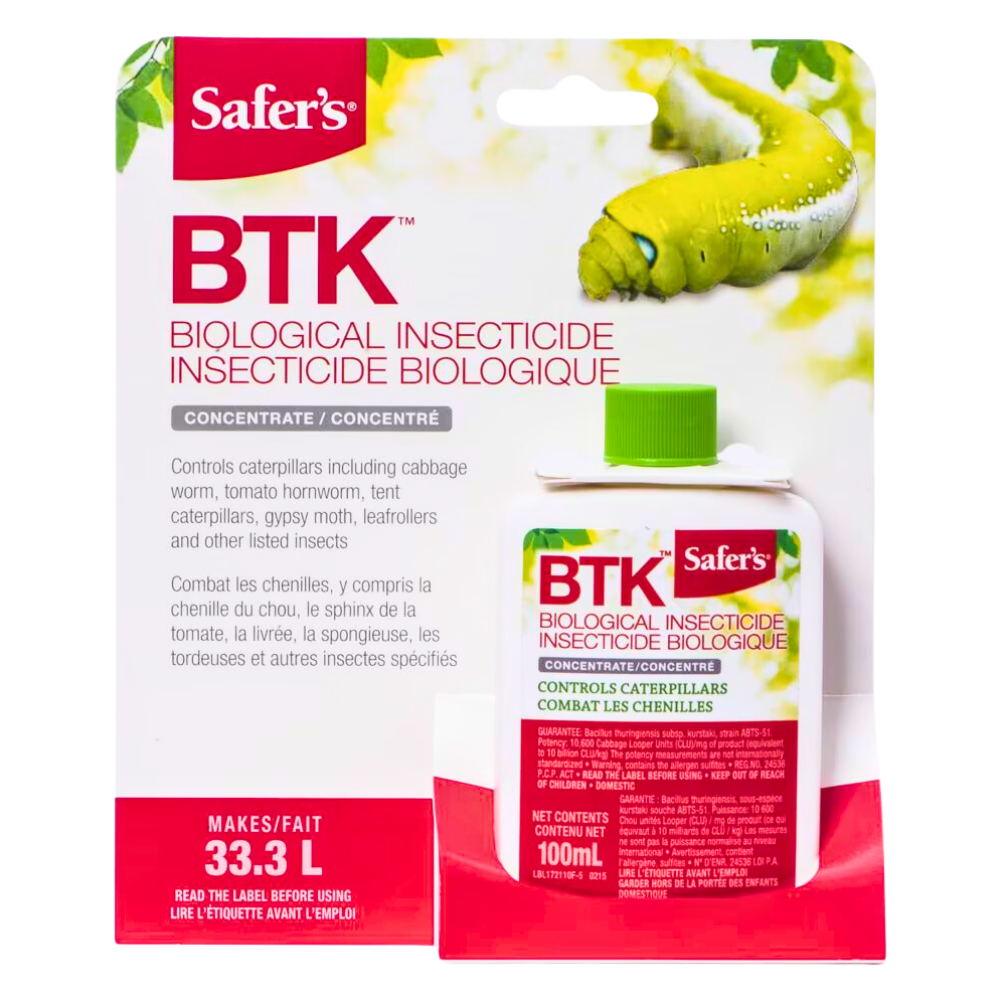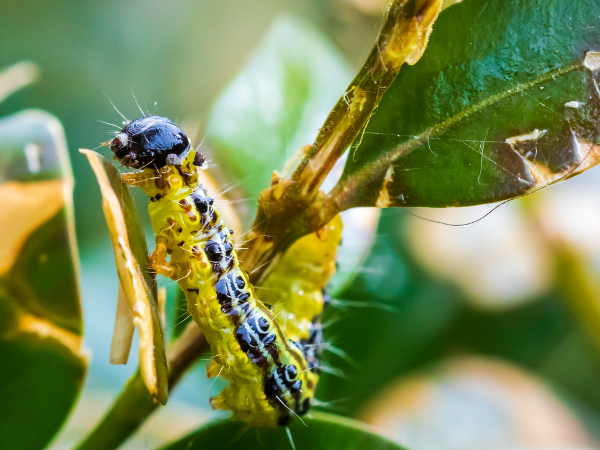
Protecting Your Boxwoods
Identifying and Treating Common Pests and Diseases
Boxwoods are beloved for their lush green foliage and versatility in garden landscapes. However, they are susceptible to various pests and diseases that can threaten their health and beauty. In St. Thomas, Ontario, gardeners should be particularly vigilant against Boxwood Psyllid, Boxwood Blight, Boxwood Leaf Miner, and Box Tree Moth. Here’s how to identify and treat each of these common problems.
1. Boxwood Psyllid

Identification:
- Symptoms: Look for cupped or distorted leaves (photo #2), particularly on new growth. This damage is caused by the feeding activity of the nymphs.
- Appearance: The nymphs are small, yellowish-green, and covered with a white ‘snow’ or cotton-like secretion (photo #3). Adults are about 1/8 inch long, greenish, and have transparent wings (photo #1).
Impact:
Boxwood psyllid damage is mainly cosmetic and does not severely harm the plant. Regular monitoring and appropriate management can help control the infestation and maintain the boxwood plants’ aesthetic quality.
- Cosmetic Damage: While it can make the plants look unsightly, it does not typically cause significant harm to the plant’s health.
- Growth Reduction: In severe infestations, there may be some plant growth reduction, but this is not common.
Treatment:
- Cultural Control: Prune and dispose of infested shoots in early spring before nymphs hatch, reducing the population for the following season.
- Chemical Control: Apply insecticidal soap, ensuring thorough coverage of all plant surfaces, including the undersides of leaves. Reapply as needed, typically every 5-7 days or after rainfall, to maintain control and prevent re-infestation.
2. Boxwood Blight
Identification:
- Symptoms: Dark or light brown leaf spots with a darker border, rapid defoliation starting on lower branches, and black streaks on stems. Infected leaves often fall off, leaving bare stems.
- Conditions: This fungal disease thrives in warm, humid conditions and spreads rapidly through water splashes and contaminated tools.
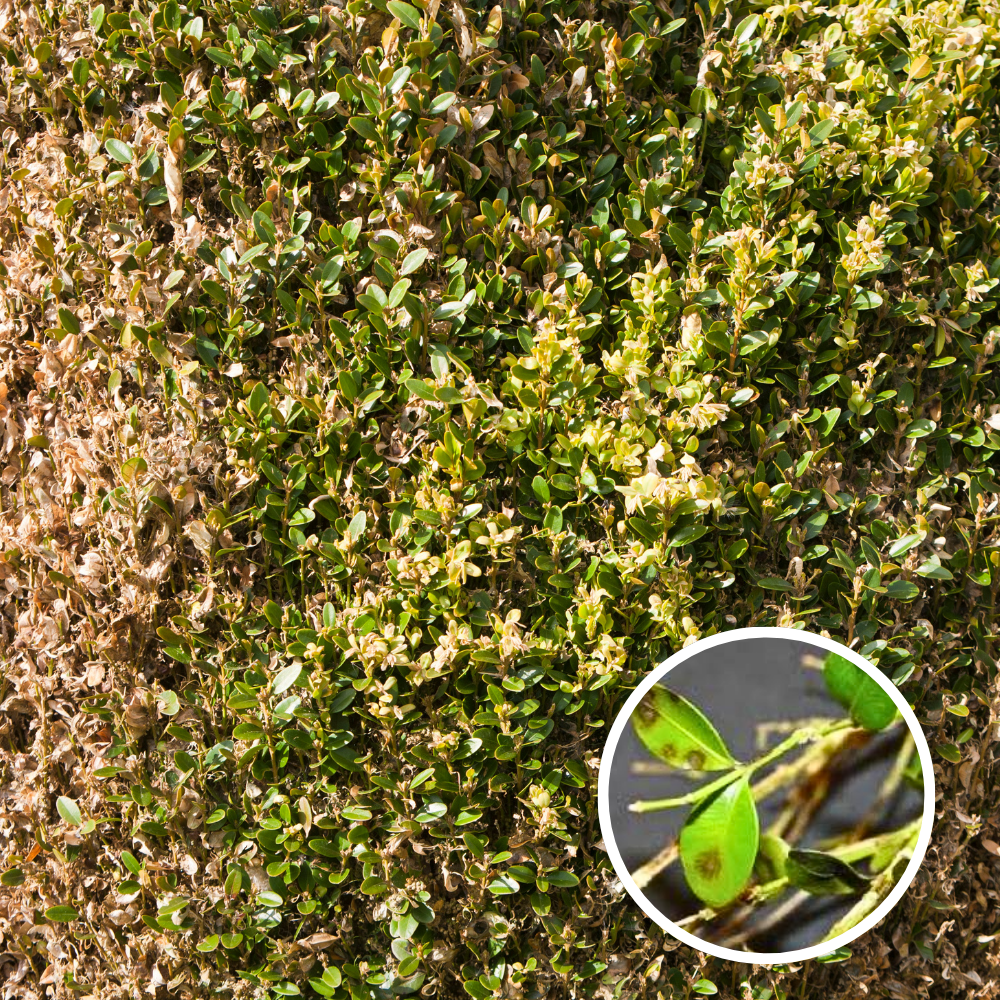
Treatment:
There is no treatment or cure for this boxwood disease. Affected shrubs must be removed and disposed of in the garbage (not in yard waste or compost). Avoid replanting boxwoods in the same area.
3. Boxwood Leaf Miner
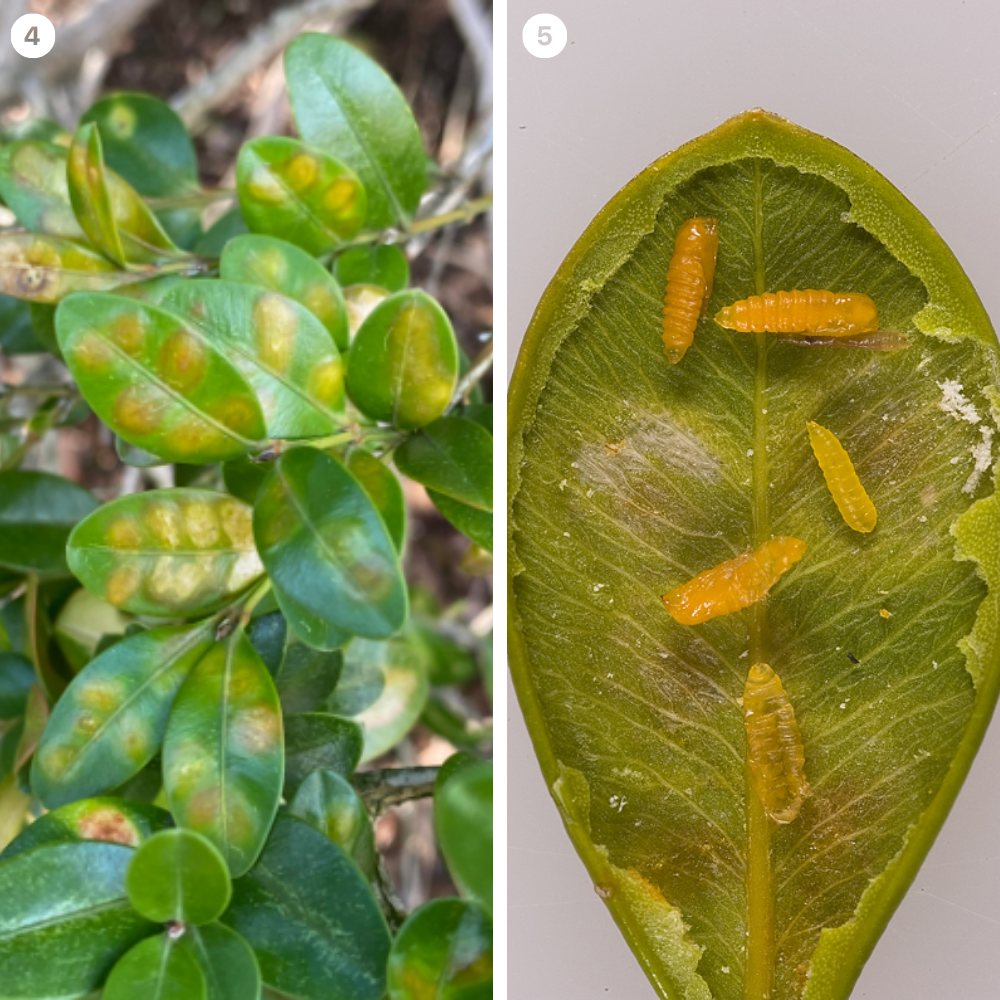
Identification:
- Symptoms: Blistered or swollen areas on the underside of leaves, yellowing, and premature leaf drop (photo #4). Adult flies are tiny and orange and lay eggs inside the leaves.
- Appearance: The larvae are small and yellowish-orange and reside inside the leaf, feeding on the tissue and causing damage (photo #5).
Treatment:
- Cultural Control: Prune and destroy infested leaves and branches before larvae pupate. Encourage natural predators like birds and parasitic wasps.
- Chemical Control: Apply insecticidal soap, ensuring thorough coverage of all plant surfaces, including the undersides of leaves. It is best to apply it in late fall or early spring. Reapply as needed, typically every 5-7 days or after rainfall, to maintain control and prevent re-infestation.
4. Box Tree Moth
Identification:
- Symptoms: Fast decline in plant health, extensive defoliation, webbing on leaves and branches, and greenish frass (insect excrement) on plants. Severe infestations can lead to plant death.
- Appearance: Caterpillars are greenish-yellow with black stripes and spots and grow up to 1.5 inches long. Adult moths have white wings with a dark brown border.
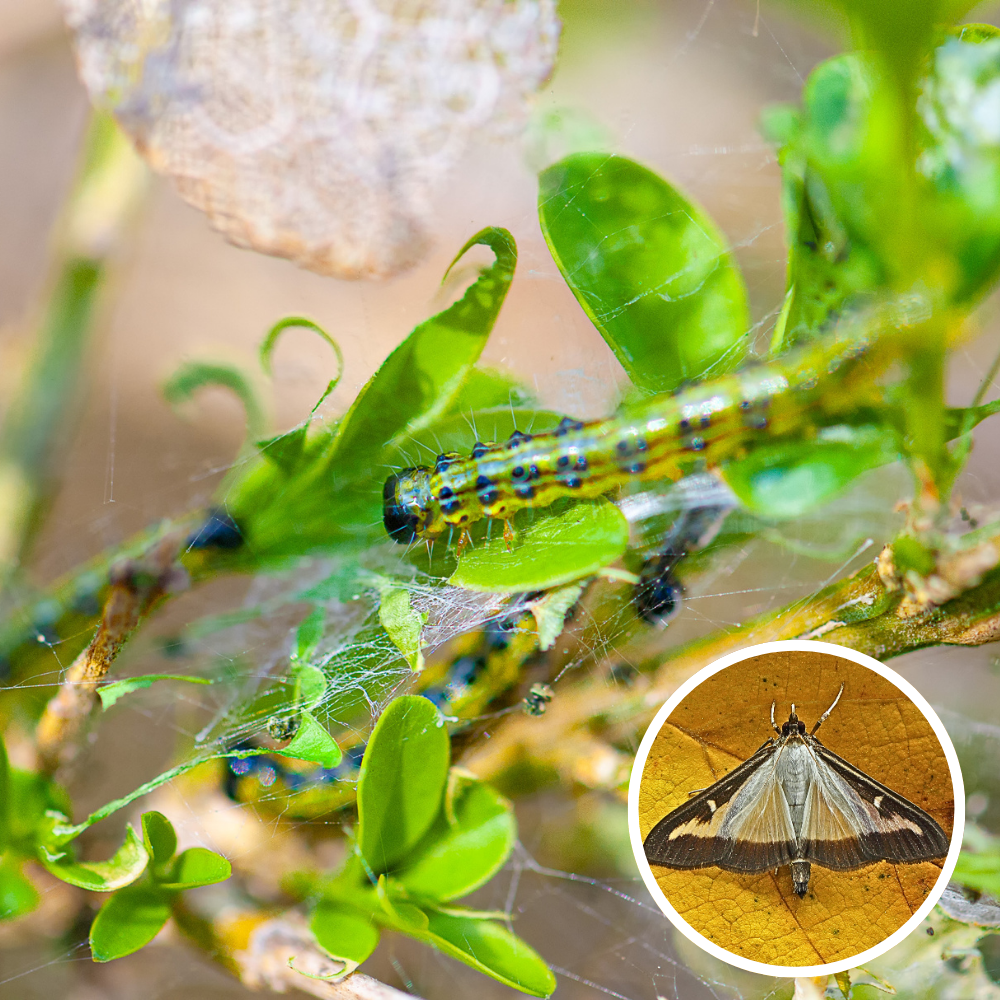
Treatment:
- Cultural Control: Inspect plants regularly and remove caterpillars and pupae manually, placing them in a container of soapy water to effectively kill them. This simple method helps prevent escape and further infestation. Prune and bag affected growth—seal in a black garbage bag, leave in direct sun for two days, then dispose of in the garbage (not compost!). Always dispose of both soapy water and plant material in the garbage—not in yard waste or compost.
- Chemical Control: BTK is an effective biological control for young caterpillars. The best time to treat is during the early stages of infestation, typically in late spring (mid-May to mid-June) and early summer (mid-July to mid-August or early to mid September), when caterpillars are actively feeding. Spray the plant as soon as the caterpillars are seen, ensuring thorough coverage of all foliage. Reapply BTK every 7-10 days during the feeding periods to maintain control and prevent re-infestation. Regular monitoring and timely applications are crucial for effective management.
About BTK
What is BTK and Why Use It?
BTK (Bacillus thuringiensis) is a naturally occurring bacterium used as a biological control agent specifically targeting caterpillar pests like the box tree moth. When caterpillars ingest BTK, it produces proteins that disrupt their digestive systems, causing them to stop feeding and ultimately die. This targeted approach makes BTK highly effective against young larvae while being safe for children, pets, and beneficial insects such as bees and butterflies. After application, it is safe for children and pets to be around treated plants.
The Importance of Caterpillar Control
Many caterpillars turn into beautiful butterflies and moths, playing crucial roles in pollination and our ecosystem. However, some caterpillars, such as those from the Box Tree Moth and the Spongy (Gypsy) Moth, can cause significant damage to our beloved plants and gardens if left unchecked. These invasive pests can defoliate plants, leading to weakened health and even plant death.
Benefits of Using BTK
BTK is a targeted solution that helps manage these harmful caterpillars, protecting our plants and harvests. It’s designed to minimize the impact on beneficial insects, allowing us to maintain a healthy and thriving garden. By using BTK responsibly, we can ensure that our gardens remain vibrant and eco-friendly while still safeguarding our plants from invasive pests. After application, it is safe for children and pets to be around treated plants, providing peace of mind for families and pet owners.

Best Practices for Healthy Boxwoods
- Regular Monitoring: Regularly inspect your boxwoods for signs of pests and diseases. Early detection is key to effective management.
- Proper Watering: Water at the base of the plants to keep foliage dry, reducing the risk of fungal infections.
- Good Sanitation: Remove and dispose of fallen leaves and pruned branches, especially if they show signs of disease or pest infestation.
- Soil Health: Ensure your boxwoods are planted in well-draining soil and are mulched appropriately to retain moisture without encouraging disease.
By staying vigilant and adopting integrated pest management practices, you can protect your boxwoods from these common threats and keep your garden looking beautiful year-round.
Photo Sources:
Missouri Botanical Garden. “Boxwood Psyllid.” Missouri Botanical Garden, https://www.missouribotanicalgarden.org/gardens-gardening/your-garden/help-for-the-home-gardener/advice-tips-resources/insects-pests-and-problems/insects/psyllids/boxwood-psyllid. Accessed May 27, 2024 (Photos #2, #3)
Missouri Botanical Garden. “Boxwood Leafminer.” Missouri Botanical Garden, https://www.missouribotanicalgarden.org/gardens-gardening/your-garden/help-for-the-home-gardener/advice-tips-resources/insects-pests-and-problems/insects/flies/boxwood-leafminer. Accessed May 27, 2024. (Photo #4)
Horticultural Trades Association. “Digital Guide to Nursery and Landscape Arthropod Pests of Ontario.” Horticultural Trades Association, https://legacy.horttrades.com/digital-guide-to-nursery-and-landscape-arthropod-pests-of-ontario. Accessed May 27, 2024 May 27, 2024. (Photos #1, #5)
